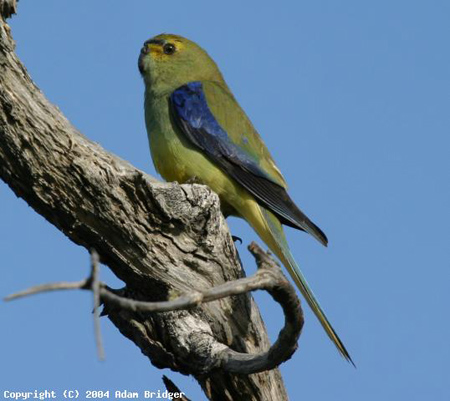
Blue-winged Parrot
[order] PSITTACIFORMES | [family] Psittacidae | [latin] Neophema chrysostoma | [authority] Kuhl, 1820 | [UK] Blue-winged Parrot | [FR] Perruche a ailes bleues | [DE] Feinsittich | [ES] Periquito Crisostomo | [NL] Blauwvleugelparkiet | [copyright picture] Alan Bridger
Subspecies
| Genus | Species | subspecies | Region | Range |
| Neophema | chrysostoma | AU | se Australia |
Genus
The genus Neophema is an Australian genus of broad-tailed parrots with six or seven species. They are small parakeets with a more or less dull green basic color with some contrasting colorful patches, and are commonly known as grass parrots. The genus has some sexual dichromatism, males having more and brighter color patches.
Physical charateristics
Male-bronze/yellow crown; deep blue frontal band up to eye and margined with paler green/blue above; olive/green upperparts; pale green cheeks to upper breast; yellow underparts and underside of tail, sometimes lightly washed with orange on centre of abdomen; cobalt blue upper wing coverts. Bill grey/black. Eye dark brown. Female-olive/green crown; less evident frontal band; duller blue upper wing coverts washed with olive/green; pale underwing stripe minimal or absent.
| wingspan min.: | 0 | cm | wingspan max.: | 0 | cm |
| size min.: | 20 | cm | size max.: | 21 | cm |
| incubation min.: | 18 | days | incubation max.: | 0 | days |
| fledging min.: | 28 | days | fledging max.: | 32 | days |
| broods: | 1 | eggs min.: | 4 | ||
| eggs max.: | 6 |
Range
Australasia : Southeast Australia. The main populations of Blue-winged Parrots are in Tasmania and Victoria, particularly in southern Victoria and the midlands and eastern areas of Tasmania. Sparser populations are found in western New South Wales and eastern South Australia, extending to south-west Queensland and occasionally into the Northern Territory
Habitat
Seen up to 1200m (3936 ft) in a varied range of habitats including savanna woodland, grasslands, orchards, forest clearings, farmland, coastal marshland, dune systems, heath, saltbush, mallee, mulga and other open areas.
Reproduction
Several pairs may nest in a single tree, forming a breeding colony. Blue-winged Parrots breed in Tasmania, coastal south-eastern South Australia and southern Victoria. They form monogamous pairs and make their nests in a tree hollow or stump, preferably one with a vertical opening. The eggs are laid on a bed of decayed wood. The female alone incubates the eggs, leaving the nest at intervals to be fed by the male, but both parents feed the nestlings. Clutch 4-6 eggs, incubted for about 18-20 days. Young fledge after another month. When choosing nest sites, Blue-winged Parrots try to get one with a small opening that will prevent predators, like Grey Shrike-thrushes, getting in to steal the eggs and young.
Feeding habits
Pairs or small parties of Blue-winged Parrots forage mainly on the ground for seeds of grasses and herbaceous plants.
Video Blue-winged Parrot
httpv://www.youtube.com/watch?v=fQDrtX29XSw
copyright: Geoffrey Dabb
Conservation
This species has a very large range, and hence does not approach the thresholds for Vulnerable under the range size criterion (Extent of Occurrence <20,000 km2 combined with a declining or fluctuating range size, habitat extent/quality, or population size and a small number of locations or severe fragmentation). The population trend appears to be stable, and hence the species does not approach the thresholds for Vulnerable under the population trend criterion (>30% decline over ten years or three generations). The population size has not been quantified, but it is not believed to approach the thresholds for Vulnerable under the population size criterion (<10,000 mature individuals with a continuing decline estimated to be >10% in ten years or three generations, or with a specified population structure). For these reasons the species is evaluated as Least Concern.

Migration
There is a definite passage of Blue-winged Parrots to and from Tasmania after breeding each year, leaving in March to April and returning in August to October. Some birds, however, over-winter in Tasmania or on the Bass Strait islands.
Distribution map

